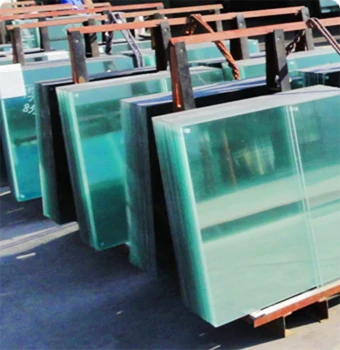The Process of Tempered Glass A Comprehensive Overview
Tempered glass, also known as toughened glass, is a type of safety glass that has been treated to enhance its strength and durability. The process of making tempered glass involves several key steps that transform ordinary glass into a product that can withstand high levels of stress and temperature variations. This article explores the intricate process of manufacturing tempered glass, its benefits, and applications.
1. Raw Material Selection
The process begins with selecting the right type of raw glass. Typically, soda-lime glass is used, which consists of silica, soda, and lime. This basic composition is crucial as it will undergo various treatments to improve its properties. The glass sheets are carefully inspected for any imperfections before proceeding to the next stage.
2. Cutting and Shaping
Once the raw glass is selected, it is cut into the desired shapes and sizes. This is done using specialized cutting tools that ensure precision. The edges of the cut glass are smoothed and polished to remove sharp edges, making it safer for handling and installation. It is essential to note that once the glass is cut, any subsequent alterations, such as drilling holes or edges, are typically not performed because this can compromise the tempered integrity.
3. Annealing
After cutting, the glass undergoes an annealing process. This involves slowly cooling the glass from its fabrication temperature to relieve internal stresses that occur during the cutting process. The annealing helps ensure that the glass maintains uniform thickness and reduces the risk of breakage later in the process.
4. Tempering
process of tempered glass
The core of the tempered glass manufacturing process is the tempering stage, which is where the glass becomes toughened. The glass sheets are then subjected to extreme heating, usually to temperatures of around 600 to 800 degrees Celsius (1,112 to 1,472 degrees Fahrenheit) in a tempering furnace. This step helps to create a uniform thermal profile throughout the glass.
Once the glass reaches the target temperature, it is rapidly cooled—this is known as quenching. The rapid cooling creates a compression layer on the surface of the glass, while the interior remains under tension. This unique combination of compressive and tensile stresses greatly enhances the strength of the glass, making it approximately four to five times stronger than untreated glass of the same thickness.
5. Quality Control
After the tempering process, the glass pieces undergo rigorous quality control inspections to ensure they meet safety and performance standards. This involves checking for any defects, such as bubbles, distortions, or discrepancies in thickness. These inspections are crucial as any flaws can compromise the integrity and safety of the tempered glass.
6. Applications of Tempered Glass
Tempered glass is widely used in various applications due to its enhanced strength and safety features. It is commonly found in the automotive industry, particularly in side and rear windows, where strength and shatter resistance are vital. In the architectural field, tempered glass is used for facades, shower doors, and glass railings, providing both safety and aesthetic appeal.
Additionally, it is used in kitchen countertops, appliances, and glass doors due to its resistance to heat and thermal shock. The versatility of tempered glass has made it a preferred material across different industries, including furniture design, commercial buildings, and interior decor.
Conclusion
The process of manufacturing tempered glass is an intricate blend of science and technology. From the careful selection of raw materials to the extreme conditions of the tempering process, each step is crucial in creating a final product that is strong, safe, and suited to various applications. As the demand for safety and durability in construction and design continues to grow, the importance of tempered glass remains significant in our modern world.
 Afrikaans
Afrikaans  Albanian
Albanian  Amharic
Amharic  Arabic
Arabic  Armenian
Armenian  Azerbaijani
Azerbaijani  Basque
Basque  Belarusian
Belarusian  Bengali
Bengali  Bosnian
Bosnian  Bulgarian
Bulgarian  Catalan
Catalan  Cebuano
Cebuano  Corsican
Corsican  Croatian
Croatian  Czech
Czech  Danish
Danish  Dutch
Dutch  English
English  Esperanto
Esperanto  Estonian
Estonian  Finnish
Finnish  French
French  Frisian
Frisian  Galician
Galician  Georgian
Georgian  German
German  Greek
Greek  Gujarati
Gujarati  Haitian Creole
Haitian Creole  hausa
hausa  hawaiian
hawaiian  Hebrew
Hebrew  Hindi
Hindi  Miao
Miao  Hungarian
Hungarian  Icelandic
Icelandic  igbo
igbo  Indonesian
Indonesian  irish
irish  Italian
Italian  Japanese
Japanese  Javanese
Javanese  Kannada
Kannada  kazakh
kazakh  Khmer
Khmer  Rwandese
Rwandese  Korean
Korean  Kurdish
Kurdish  Kyrgyz
Kyrgyz  Lao
Lao  Latin
Latin  Latvian
Latvian  Lithuanian
Lithuanian  Luxembourgish
Luxembourgish  Macedonian
Macedonian  Malgashi
Malgashi  Malay
Malay  Malayalam
Malayalam  Maltese
Maltese  Maori
Maori  Marathi
Marathi  Mongolian
Mongolian  Myanmar
Myanmar  Nepali
Nepali  Norwegian
Norwegian  Norwegian
Norwegian  Occitan
Occitan  Pashto
Pashto  Persian
Persian  Polish
Polish  Portuguese
Portuguese  Punjabi
Punjabi  Romanian
Romanian  Russian
Russian  Samoan
Samoan  Scottish Gaelic
Scottish Gaelic  Serbian
Serbian  Sesotho
Sesotho  Shona
Shona  Sindhi
Sindhi  Sinhala
Sinhala  Slovak
Slovak  Slovenian
Slovenian  Somali
Somali  Spanish
Spanish  Sundanese
Sundanese  Swahili
Swahili  Swedish
Swedish  Tagalog
Tagalog  Tajik
Tajik  Tamil
Tamil  Tatar
Tatar  Telugu
Telugu  Thai
Thai  Turkish
Turkish  Turkmen
Turkmen  Ukrainian
Ukrainian  Urdu
Urdu  Uighur
Uighur  Uzbek
Uzbek  Vietnamese
Vietnamese  Welsh
Welsh  Bantu
Bantu  Yiddish
Yiddish  Yoruba
Yoruba  Zulu
Zulu 

